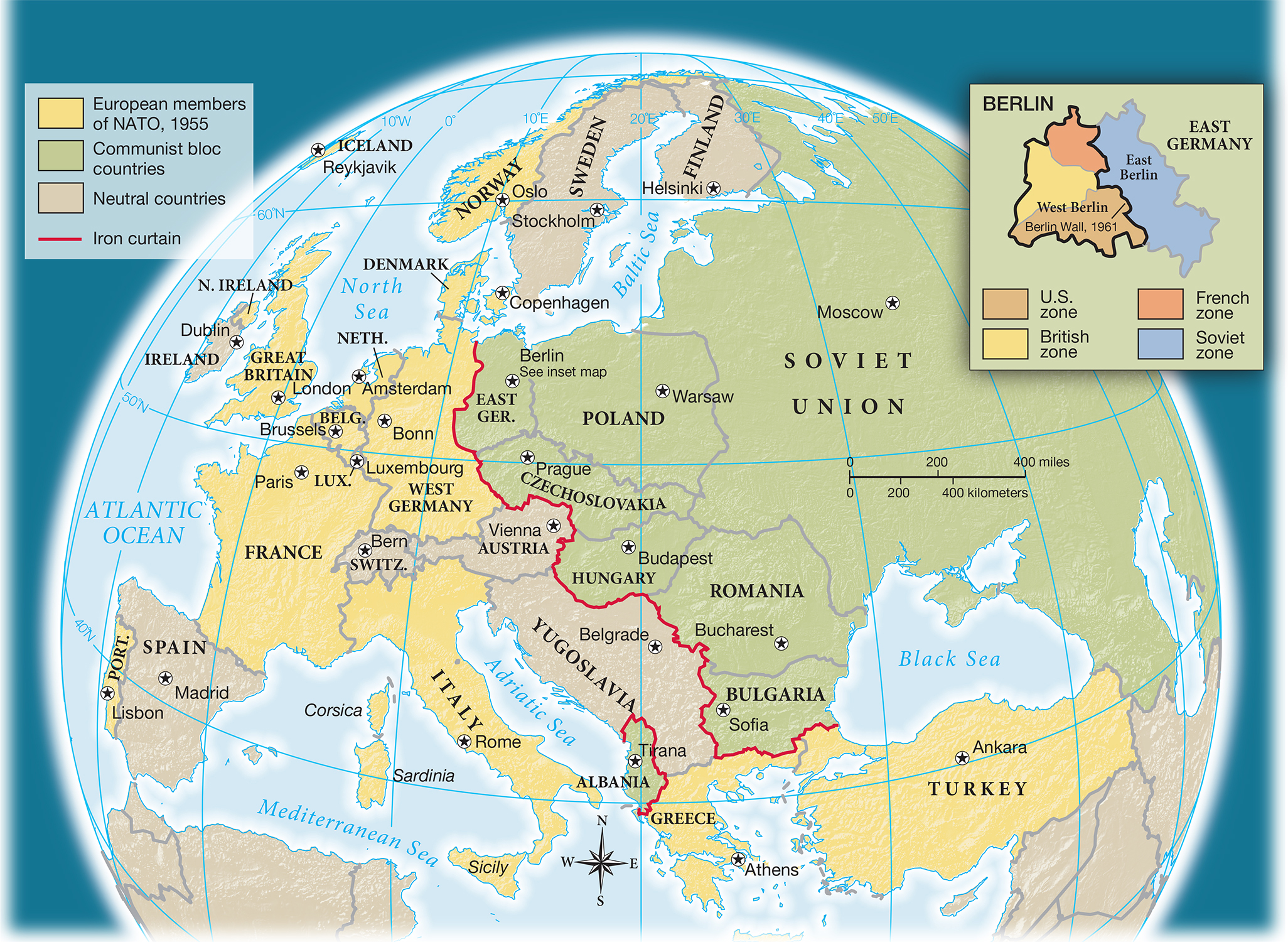The Cold War Begins
“The guys who came out of World War II were idealistic,” reported Harold Russell, a young paratrooper who had lost both hands in a training accident. “We felt the day had come when the wars were all over.” But such hopes were quickly dashed. Once the Allies had overcome a common enemy, the prewar mistrust and antagonism between the Soviet Union and the West resurfaced over their very different visions of the postwar world.
The Western Allies’ delay in opening a second front in Western Europe aroused Soviet suspicions during the war. The Soviet Union made supreme wartime sacrifices, losing more than twenty million citizens and vast portions of its agricultural and industrial capacity. Soviet leader Joseph Stalin wanted to make Germany pay for Soviet economic reconstruction and to expand Soviet influence in the world. Above all, he wanted friendly governments on the Soviet Union’s borders in Eastern Europe, through which his nation had been attacked twice in the past twenty-
In contrast to the Soviet devastation, American losses were relatively light, and the United States emerged from the war as the most powerful nation on the planet, with a vastly expanded economy and a monopoly on atomic weapons. That sheer power, along with U.S. economic interests and a belief in the superiority of American institutions and intentions, all affected how American leaders approached the Soviet Union.
With the depression still fresh in their minds, American officials believed that a healthy economy depended on opportunities abroad. American companies needed access to raw materials, markets for their goods, and security for their investments overseas. These needs could be met best in countries with similar economic and political systems. As President Harry S. Truman put it in 1947, “The American system can survive in America only if it becomes a world system.” Yet leaders and citizens alike regarded their foreign policy not as a self-
Recent history also shaped postwar foreign policy. Americans believed that World War II might have been avoided had Britain and France resisted rather than appeased Hitler’s initial aggression. Navy Secretary James V. Forrestal argued against trying to “buy [the Soviets’] understanding and sympathy. We tried that once with Hitler.” The man with ultimate responsibility for U.S. policy was a keen student of history but came to the White House with little international experience beyond his service in World War I. Harry S. Truman anticipated Soviet-
The Cold War first emerged over clashing Soviet and American interests in Eastern Europe. Stalin insisted that wartime agreements gave him a free hand in the countries defeated or liberated by the Red Army, just as the United States was unilaterally reconstructing governments in Italy and Japan. The Soviet dictator used harsh methods to install Communist governments in neighboring Poland and Bulgaria. Elsewhere, Stalin initially tolerated non-
Stalin saw hypocrisy when U.S. officials demanded democratic elections in Eastern Europe while supporting dictatorships friendly to U.S. interests in Latin America. The United States clung to its sphere of influence while opposing Soviet efforts to create its own. But the Western Allies were unwilling to match tough words with military force against the largest army in the world. They protested strongly but failed to prevent the Soviet Union from establishing satellite countries throughout Eastern Europe (Map 26.1).

In 1946, the wartime Allies contended over Germany’s future. Both sides wanted to demilitarize Germany, but U.S. policymakers sought rapid industrial revival there to foster European economic recovery and thus America’s own long-
The war of words escalated early in 1946. Boasting of the superiority of the Soviet system, Stalin told a Moscow audience in February that capitalism inevitably produced war. One month later, Truman accompanied Winston Churchill to Westminster College in Fulton, Missouri, where the former prime minister denounced Soviet interference in Eastern Europe. “From Stettin in the Baltic to Trieste in the Adriatic, an iron curtain has descended across the Continent,” Churchill said. (See “Documenting the American Promise.”) Stalin saw Churchill’s proposal for joint British-
In February 1946, George F. Kennan, a career diplomat and expert on Russia, wrote a comprehensive rationale for what came to be called the policy of containment. Downplaying the influence of Communist ideology in Soviet policy, he instead stressed Soviet insecurity and Stalin’s need to maintain authority at home, which, he believed, prompted Stalin to exaggerate threats from abroad and expand Soviet power. Kennan believed that the Soviet Union would retreat from its expansionist efforts if the United States would respond with “unalterable counterforce.” This approach, he predicted would eventually end in “either the breakup or the gradual mellowing of Soviet power.”
Not all public figures agreed. In September 1946, Secretary of Commerce Henry A. Wallace urged greater understanding of the Soviets’ national security concerns, insisting that “we have no more business in the political affairs of Eastern Europe than Russia has in the political affairs of Latin America.” (See “Documenting the American Promise.”) State Department officials were furious at Wallace for challenging the administration’s hard line against the Soviet Union, and Truman fired Wallace.